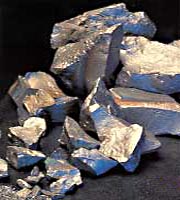NON FERROUS METALS
all grades
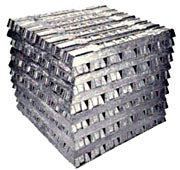
| Element: | Calcium |
| Symbol: | Ca |
| Atomic number: | 20 |
| Atomic weight: | 40.08 |
| Density, 20 C (68 F): | 1.53 g/cm3 |
| Melting point: | 850 C (1562 F) |
| Boiling point: | 1350 C (2462 F) |
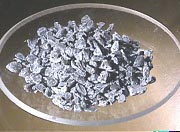
Calcium, as limestone, has always been a basic ingredient in iron and steelmaking. Its uses as a fluxing agent are well known. Treatment of liquid steel with calcium has become an important means of deoxidation and, more importantly, desulfurization to previously unthinkable levels. Equally significant is the now routine use of calcium to control the shape, size and distribution of oxide and sulfide inclusions. Benefits directly attributable to calcium treatment include greater fluidity, simplified continuous casting and improved cleanliness, machinability, ductility and impact strength in the final product. Calcium silicon, containing 28-35% Ca, 60-65% Si and 6% Fe, is the most commonly used addition agent. It may contain up to 1 % C and 1.5% Al. Availability 99,9 % Ca all sizes
| Element: | Magnesium |
| Symbol: | Mg |
| Atomic number: | 12 |
| Atomic weight: | 24.32 |
| Density, 20 C (68 F): | 1.74 g/cm3 |
| Melting point: | 650 C (1202 F) |
| Boiling point: | 1105 C (2021 F) |
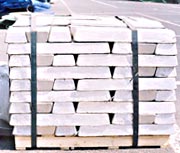
Magnesium is essentially insoluble in solid steel and is not used as an alloying constituent per se. However, like calcium, magnesium is very useful as a desulfurizer, and large quantites have been consumed in steelmaking for this purpose. Magnesium is a powerful inoculant in cast iron. When added in concentrations exceeding 0.04%, it produces a spheroidal form of graphite that improves the iron’s strength and ductility. Availability all grades
| Element: | Magnesium |
| Symbol: | Mg |
| Atomic number: | 12 |
| Atomic weight: | 24.32 |
| Density, 20 C (68 F): | 1.74 g/cm3 |
| Melting point: | 650 C (1202 F) |
| Boiling point: | 1105 C (2021 F) |

Magnesium is essentially insoluble in solid steel and is not used as an alloying constituent per se. However, like calcium, magnesium is very useful as a desulfurizer, and large quantites have been consumed in steelmaking for this purpose. Magnesium is a powerful inoculant in cast iron. When added in concentrations exceeding 0.04%, it produces a spheroidal form of graphite that improves the iron’s strength and ductility. Availability ingots 7,5 kg, 1 kg, 0,5 kg, 0,3 kg, 0,1 kg powder
| Element: | Manganese |
| Symbol: | Mn |
| Atomic number: | 25 |
| Atomic weight: | 54.93 |
| Density, 20 C (68 F): | 7.44 g/cm3 |
| Melting point: | 1244 C (2271 F) |
| Boiling point: | 2095 C (3803 F) |

Manganese is intentionally present in most grades of steel and is a residual constituent of virtually all others. Aside from its historic importance as a desulfurizer and deoxidizer, manganese is undoubtedly the most prevalent alloying agent in steels, after carbon. Understandably, therefore, ferromanganese is the most widely used ferroalloy. Availability lumps and flakes
50 % CE
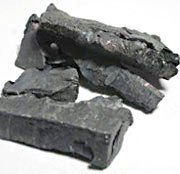
| Element: | Nickel |
| Symbol: | Ni |
| Atomic number: | 28 |
| Atomic weight: | 58.69 |
| Density, 20 C (68 F): | 8.902 g/cm3 |
| Melting point: | 1455 C (2651 F) |
| Boiling point: | 2910 C (5270 F) |

An important and widely used constituent of alloy steels, nickel is best known as a soid solution strengthener, a mild hardenability agent and, most important, as a means of promoting high toughness, especially at low temperatures. Nickel was probably the first of the modern alloying agents; some nickel steels were commercially produced around the turn of the century. Upwards of 8% nickel is used to produce the austenitic structure in 300-series stainless steels. Wrought steels, including stainless, consume 55% of free world production. In the concentrations found in low alloy steels, nickel has a modest but beneficial effect on atmospheric corrosion resistance. At the other end of the spectrum, nickel forms the basis for an extensive and important family of superalloys and heat-, oxidation- and corrosion-resistant materials. Availability
- pellets, strips, squares
- oxide
- salts for electroplating – sulphate, chloride
- powder
Nickel Pellets Typical Chemical Analysis (percent)
| Nickel | 99.48 | Sulfer | 0.005 | |
| Cobalt | <0.00005 | Copper | 0.0002 | |
| Iron | 0.006 | Zinc | <0.00005 | |
| Carbon | 0.011 | Lead | <0.00002 |
Nickel Strips Typical Chemical Analysis (percent) Nickel plus cobalt – 99.99
| Cobalt | 0.050 | Sulfer | 0.0002 | |
| Copper | 0.001 | Arsenic | 0.001 | |
| Carbon | 0.003 | Lead | 0.0001 | |
| Iron | 0.0005 | Zinc | 0.0003 |
Nickel Squares Typical Chemical Analysis (percent)
| Nickel | 99.92 | Sulfer | <0.001 | |
| Cobalt | 0.06 | Copper | 0.003 | |
| Iron | <0.0005 | Zinc | 0.0003 | |
| Carbon | 0.002 | Lead | <0.00002 |
Nickel Sulfate Typical Chemical Analysis (percent)
| Ni | 24.4 | Cu | 0.001 | |
| Co | 0.0003 | Fe | 0.004 | |
| Pb | 0.0001 | Zn | 0.0002 |
Nickel Chloride Typical Chemical Analysis (percent)
| Ni | 24.7 | Cl | 0.001 | |
| Co | 0.0003 | Cu | 0.001 | |
| Pb | 0.0001 | Fe | 0.003 | |
| Zn | 0.0002 | Na | <0.01 |
Nodular/Ductile Pig Iron
Basic Pig Iron, all grades
Hematite Pig Iron, all grades
Phosphorous Pig Iron
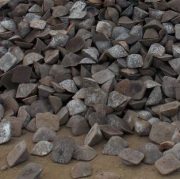
| Element: | Silicon |
| Symbol: | Si |
| Atomic number: | 14 |
| Atomic weight: | 28.09 |
| Density, 20 C (68 F): | 2.34 g/cm3 |
| Melting point: | 1412 C (2573 F) |
| Boiling point: | 2355 C (4270 F) |
Silicon, the second most abundant element in the Earth’s crust (25.7%), is present in virtually all steels, either as a residual from ore, scrap or deoxidants, or as an intentional addition. Availability 5/5/3, 4/4/1, 2/2/1 high grade, low P 30 ppm max.
